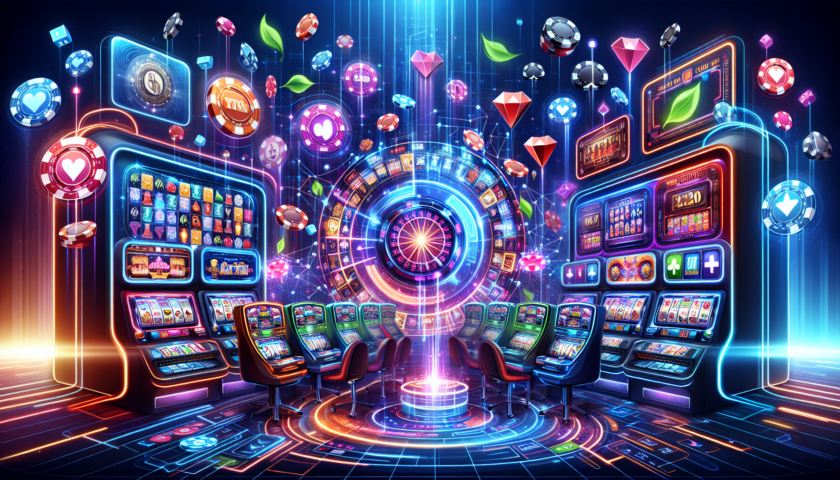In the evolving world of online gaming, a new wave of platforms is emerging, blending gaming with virtual worlds in ways that go beyond traditional gameplay. These platforms, inspired by the concept of the metaverse, are transforming how players interact, create, and engage in digital experiences. This article delves into the metaverse-inspired gaming platforms, how they are shaping the future of Hoki805 online entertainment, and what makes them so unique.
The Metaverse: A New Frontier for Online Gaming
The term “metaverse” has gained considerable attention in recent years, especially with the rise of tech giants like Meta (formerly Facebook) announcing their vision for a fully immersive virtual world. While the metaverse is still in its early stages, its influence is already evident in the evolution of online gaming platforms. In these virtual spaces, users can engage not just in gaming, but also in social activities, virtual commerce, and creative endeavors—blurring the lines between a game and a fully realized digital universe.
Key Features of Metaverse-Inspired Gaming Platforms
1. Interactivity Beyond Gaming
Unlike traditional online games, which often focus solely on competitive or cooperative play, metaverse-inspired platforms emphasize a more immersive, interactive experience. These platforms offer a virtual world where players can not only play games but also socialize, attend events, and even create their own content. Players can participate in concerts, art exhibitions, and virtual marketplaces, often using customizable avatars that represent them in the digital space.
2. Play-to-Earn Economy
A significant shift in the online gaming world is the integration of blockchain and cryptocurrency, making way for play-to-earn (P2E) economies. On these platforms, players can earn real-world value by participating in the virtual economy—whether it’s by winning competitions, creating digital assets, or selling virtual goods. Games like Decentraland and The Sandbox allow players to create virtual land, build experiences, and trade NFTs, giving rise to an entirely new economic model.
3. User-Generated Content
Another unique aspect of these metaverse-inspired platforms is the focus on user-generated content. Unlike traditional games where developers design most of the content, these platforms encourage players to create and shape the virtual world around them. In Roblox, for example, users can design their own games, from simple obstacle courses to complex role-playing experiences, and share them with the community. This level of creativity fosters a thriving ecosystem where players have significant ownership over the content they consume.
4. Virtual and Augmented Reality Integration
Many metaverse-inspired gaming platforms are embracing virtual reality (VR) and augmented reality (AR) technologies to create fully immersive experiences. VR headsets, like the Oculus Rift, allow players to enter 3D spaces, making them feel as though they are physically present in the virtual world. AR, on the other hand, overlays digital elements onto the real world, allowing for innovative gameplay experiences where the lines between reality and the digital realm are blurred.
5. Cross-Platform Play
One of the defining features of modern online gaming platforms is the ability to play across multiple devices. Metaverse-inspired platforms often support cross-platform play, allowing users to interact with others regardless of whether they are on PC, console, or mobile. This ensures that players can seamlessly engage with the digital world, no matter their preferred device.
Popular Metaverse-Inspired Gaming Platforms
- Roblox Known for its expansive user-generated content, Roblox allows players to create and explore virtual worlds. Its easy-to-use development tools have made it a hit among younger audiences, while its virtual economy allows users to buy, sell, and trade items. Roblox is becoming more than just a gaming platform—it’s a social experience where millions of players gather for events and experiences.
- Decentraland As a blockchain-based virtual world, Decentraland enables players to buy virtual land, build structures, and participate in various activities. It incorporates a play-to-earn economy, allowing players to monetize their virtual assets through the use of NFTs. Decentraland represents the convergence of gaming, art, and digital real estate, and it is attracting artists, developers, and entrepreneurs alike.
- The Sandbox Similar to Decentraland, The Sandbox is a decentralized platform where users can buy, sell, and trade virtual land and assets. What sets The Sandbox apart is its focus on gaming experiences, where creators can build their own games using a suite of development tools. This platform is also heavily integrated with NFTs, giving players the opportunity to own a piece of the virtual world.
- VRChat VRChat is a social platform that emphasizes user creativity and interaction. Players can design and upload their own worlds, avatars, and experiences, fostering a vibrant community of creators. With support for VR headsets, VRChat offers a truly immersive experience, where users can chat, play games, or simply explore the many virtual spaces built by others.
- Second Life Launched in 2003, Second Life is one of the pioneers of virtual worlds and has maintained a loyal user base for decades. While it may not have the flashy graphics of modern games, its focus on social interaction, virtual commerce, and user-driven content make it a unique platform that has influenced the development of many newer metaverse-inspired games.
The Future of Online Gaming Platforms
As technology continues to advance, metaverse-inspired gaming platforms will likely become even more immersive and integrated with other aspects of daily life. The rise of virtual reality, blockchain, and artificial intelligence could revolutionize the way we interact with digital worlds, creating experiences that are indistinguishable from reality.
